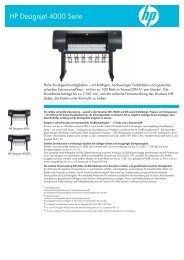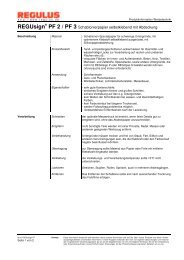STOCHASTIC HALFTONE SCREENING
STOCHASTIC HALFTONE SCREENING
STOCHASTIC HALFTONE SCREENING
You also want an ePaper? Increase the reach of your titles
YUMPU automatically turns print PDFs into web optimized ePapers that Google loves.
C G T T E C H N I C A L P U B L I C A T I O N S<br />
The natural extension of the glass<br />
halftone screen was the flexible contact<br />
screen. This was a film-based halftone<br />
screen, still oriented on a grid, that allowed<br />
the halftone image to be produced when<br />
the contact screen was held in place against<br />
unexposed film on the camera back. The<br />
contact screen was much easier and safer to<br />
use than the fragile and expensive glass<br />
contact screens. It is still in wide use today<br />
as either a grey or magenta screen in a<br />
designated line ruling and predetermined<br />
angle.<br />
As the plastic contact screen gained<br />
popularity, there were other versions<br />
developed based on special effects. The<br />
most notable was the common mezzotint<br />
that was based on the reticulated grain<br />
pattern that could be produced during the<br />
processing of conventional photographic<br />
film. The mezzotint pattern was used<br />
primarily as a special effect texture screen<br />
because the image generated by this<br />
pattern tended to be “wormy” and was<br />
quite coarse.<br />
An extension of the mezzotint was the<br />
first true random grain halftone screen. It<br />
was generated using the enlarged grain of<br />
the photographic film itself. If you have<br />
ever done any black and white photography<br />
and enlarging, you will remember the<br />
“grainy” appearance that resulted from<br />
using fast photographic emulsions with an<br />
ISO speed over 400. This appearance was<br />
the result of the enlargement of actual<br />
silver halide crystals of the film emulsion.<br />
Halftone screens using this method were<br />
available in Europe during the 1960’s from<br />
Polichrome of Italy and are still available<br />
today. This random grain contact screen<br />
was available in coarse and fine designations<br />
and were used primarily for special<br />
effects.<br />
During the early 1970s there were a<br />
number of individuals in Germany who<br />
were working on a method of electroni-<br />
cally generating a random grain halftone<br />
dot. At this time electronic scanners were<br />
just beginning to appear in the prepress<br />
market and were limited to the very largest<br />
companies because of their extreme cost.<br />
Development was limited primarily to the<br />
mathematics of the randomization algorithms<br />
and experimentation was limited<br />
because of the high cost of computing<br />
power. For all practical purposes there was<br />
little, if any, commercial application of the<br />
algorithms as an electronic dot generating<br />
mechanism.<br />
During the 1980s things began to<br />
change as electronic scanners began to<br />
proliferate and the cost of computing<br />
horsepower began to decline. The first<br />
patents for practical application of random<br />
dot were issued to Hell Graphic Systems<br />
about 12 years ago. Random dot generation<br />
has been available on a commercial<br />
basis in Europe since 1988 or 1989.<br />
It has been only the last two or three<br />
years where extensive development of<br />
stochastic screening has gained industry<br />
attention. While it has been widely known<br />
in academic industry circles, it has found<br />
only limited application until the widespread<br />
use of Adobe Postscript® as the<br />
electronic page description language of the<br />
desktop publisher. As more and more laser<br />
imagesetters began to appear in the<br />
graphic arts marketplace, the problems<br />
associated with the generation of fine line<br />
halftones became more and more apparent.<br />
The majority of imagesetters on the<br />
market did not possess the quality of<br />
electronic dot generation that the high-end<br />
scanners do. This is understandable<br />
because they cost much less and the<br />
limitations of the programming language<br />
place significant limits on the ability to<br />
electronically generate a halftone dot. In<br />
an effort to improve the fine line capability<br />
of the imagesetter, electronic halftone<br />
designers came up against increasingly<br />
TECH LIBRARY<br />
ONLINE<br />
TECHNICAL<br />
SUPPORT<br />
©1994 Coudray Graphic Technologies :: 805.541.1521 <strong>STOCHASTIC</strong> <strong>HALFTONE</strong> <strong>SCREENING</strong><br />
2
















